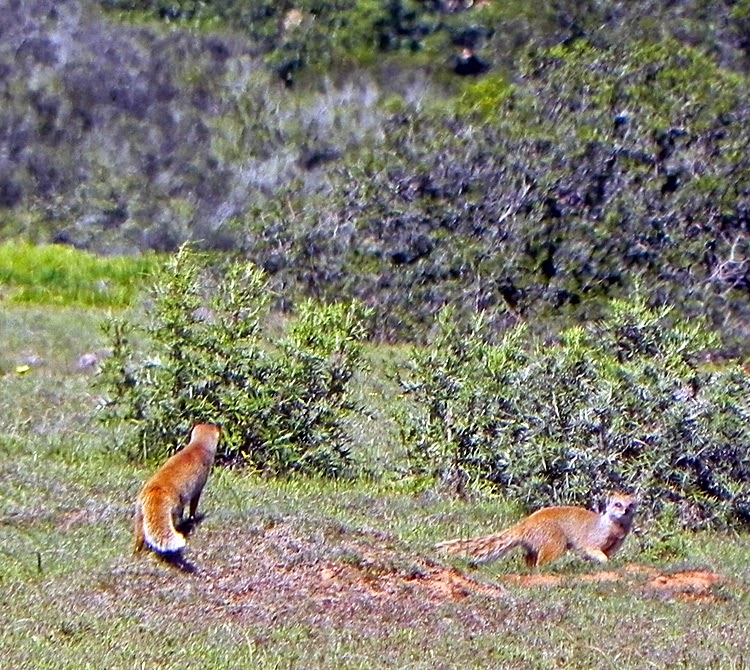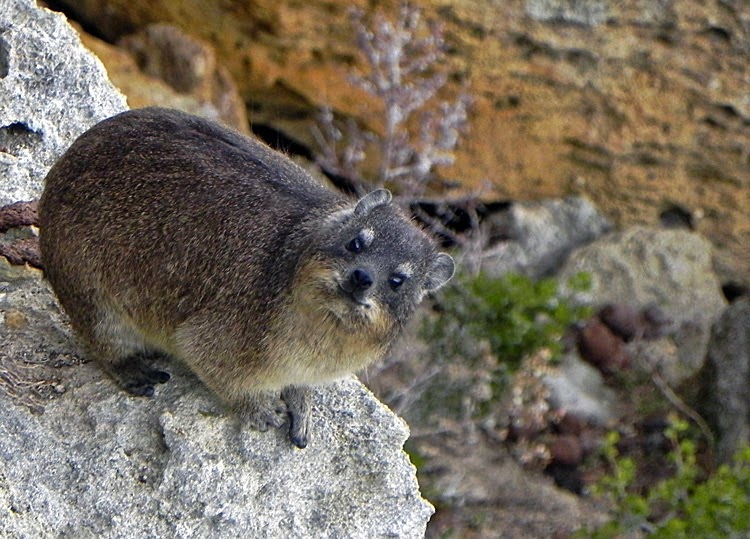 |
| Early morning view from the camp site |
The reserve doesn't offer a lot in terms of mammal watching, and since I wanted to relax I didn't focus very hard on game watching. Still, it was a fun trip and I saw plenty of cool things. The reserve is quite close to home (about 200km) and I'm sure I'll be back.
During this trip (and in general) I don't like to bother too much with taking "good" photographs, and rather spend some time to enjoy the experiences. So, the photographs here aren't anything spectacular. Just simple "point and shoot" attempts.
 |
| Macro photography on the tidal rocky shores can reveal a whole new world |
My camera traps were at home when I got ready for the trip, for some TLC. I decided to take a few with me to the reserve. Unfortunately there were a lot of Baboons in the area, so I didn't want to take unnecessary risks with the camera traps. Especially since there is a chance that the Baboons have learnt to recognise and target human-made-stuff.
I was mostly interested in taking a break and enjoying my holiday. As a result I didn't get around to doing any real camera trapping.
I opted to book a camping site, since I haven't camped in a tent in a while and thought it would be fun. Camping brings its own charm and experiences. Thanks to that decision I managed to return home with camera trap photographs of one mammal species.
 |
| Cape Gerbil (Kaapse Springmuis - Tatera afra) putting it's best foot forward for my Birdcam 2.0 |
Each night, just after sunset, this little fellow would start scurrying around at the back of my tent. This would continue for a few minutes and then the gerbil would wonder off. Sometime after 12am it would return once more to scratch around in the dirt. After the second visit it would disappear until the next night. Where it went and why it visited each night, at more or less the same times, I don't know.
I had my Bushnell Trophy Cam at hand and got some video clips as well.
Video: Cape Gerbil scratching the ground at the back of my tent
I'm not sure what the gerbil is doing? I put some broken biscuits out as bait, but it didn't pay much attention to it, preferring to rather scratch around in the soil. Cape Gerbils are plant eaters for the most part, but maybe they'll also eat the odd insect? I'm not sure what this one was hunting for each night in the topsoil...
On the last night I decided to try and see the little fellow for myself (not only on camera trap photos). The scratching starting right on time and I sneaked a peak. I even managed to take some photos and video clips using my mobile phone.
 |
| As long as the gerbil didn't see my face it wasn't too stressed out about the light |
Video: A video clip of the Cape Gerbil keeping me company outside my tent
All in all the rodent was a pleasure to have around the camp site and didn't cause any problems. No, it didn't chew on anything I own. People often think of all rodents as "mice" or "rats" that create unhealthy nests that stink, or as pests that destroy furniture. The truth is that most rodents are good citizens. In particular almost all wild species are shy and reclusive in nature, with specialised diets and do not ever cause any problems of any kind to us humans.
On the other end of the size scale the reserve is also famous for the Southern Right Whales that visit the shoreline during our winter and spring months.
 |
| Southern Right Whale (Noorkapper - Eubalaena australis) resting in the waves |
At first I wasn't sure how easy it would be to spot a whale, but when I got to the viewing deck I easily counted at least 12 rolling on the waves. It really is a good place to visit if you wish to see some whales.
Highest on my wish list were the Cape Vultures, classified as Vulnerable by the IUCN.
 |
| Cape Vulture (Kransaasvoël - Gyps coprotheres) souring overhead |
As I started the hiking trail I only glimpsed one or two in the distance, but luckily on my way back a few more came in and I got some good views.
Video: I tried to photographs the spiralling column, but I'm not sure how easy it will be to see...
One of my favourite species at the reserve is the Yellow Mongoose. Luckily they were fairly common near the main camp area.
 |
| Yellow Mongoose (Rooimeerkat - Cynictis penicillata) doing a good job of staying out of zoom range... |
I just couldn't manage to get close enough to one to get a proper photograph! They just do not sit still for long enough and the ones I encountered were skittish of humans, or maybe it was the fact that I was paying them a lot more attention the average visitor does.
An interesting thing about the Yellow Mongoose is that it is a natural reservoir for Rabies, with some individuals able to carry the disease (infectiously) for several years.
There were many other birds and animals around the camp area. The Dassie and Scrub Hare were rather tame and presented some good views.
 |
| Dassie/Rock Hyrax (Klipdassie - Procavia capensis) giving us one of those infamous Dassie smiles |
 |
| Scrub Hare (Kolhaas - Lepus saxatilis) out and about well before sunset |
I'll wrap up with a few photographs of flowers (and Monkey Beetles) I spotted while walking the hiking trails in search of the Cape Vultures.










